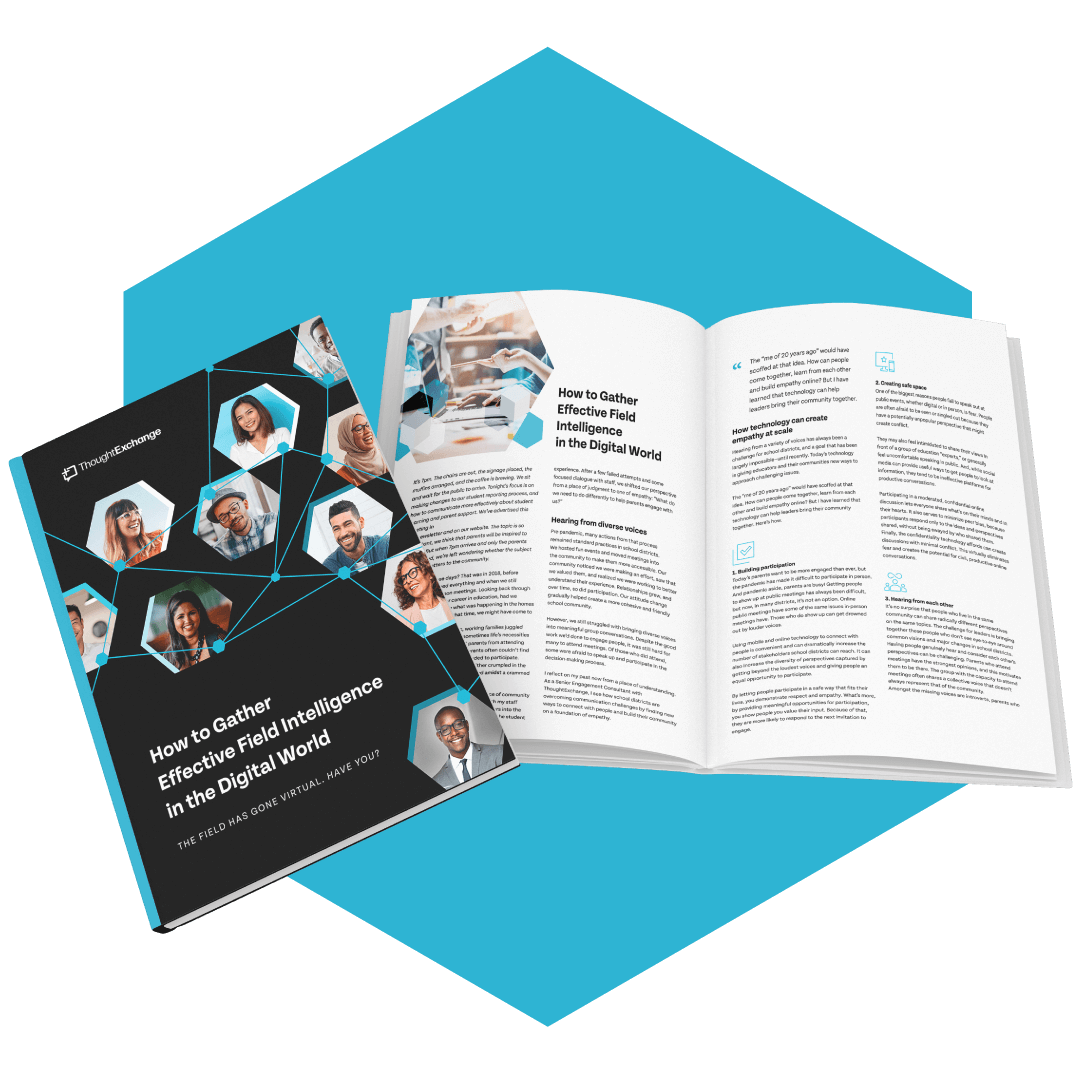







Forget Conventional Wisdom, You Need Evidence-Based Management
What else, besides evidence, do you use to make decisions?
This may seem like an odd question to most leaders—especially in a world where we have so much data at our fingertips. But, as it turns out, there are a lot of other factors that affect our decisions, whether we intend them to or not.
We make hundreds of decisions every day—from the coffee we order to the candidate we select for an interview—and hype, bias, opinion, belief systems, ego, and stress influence our choices.
Evidence-based management is an approach that involves consciously setting aside the accepted conventions and hierarchy of opinion, and instead, using critical thinking and the best available evidence to make decisions. Using it to make managerial and people-related decisions can drive better outcomes in every aspect of a business, from diversity and inclusion to profitability.
→ Download Now: How to Gather Effective Field Intelligence in the Digital World
Table of contents
- What is Evidence-Based Management?
- How to Use Evidence-Based Management
- Sources of Evidence for Leaders
- Tools to Enable Evidence-Based Management

What is Evidence-Based Management?
Have you ever made a decision based on so-called "best practices"? If you have—and if you haven’t questioned the culture, myths, and ideologies that contributed to those practices—your decision-making framework is fundamentally flawed.
Falling back on acquired best practices can result in bad decisions, poor business outcomes, and a limited understanding of why things went wrong in the first place. Adoption of evidence-based management approaches can prevent this.
Evidence-based management is a practice of management and decision-making based on critical thinking and reliable evidence. The practice became popular in medicine in the 1990s when a Canadian-American physician, Dr. David Sackett, defined evidence-based practice as “the conscientious, explicit, and judicious use of current best evidence in making decisions about the care of individual patients.”
While this sounds like a pretty basic expectation of medical practitioners, there are many cases where stress, workload, and other factors hinder decision-making and result in poorer patient outcomes. In the last decade or so, evidence-based practice spread to other disciplines like public policy, education, and business management.
How to Use Evidence-Based Management
Evidence-based management makes us more effective and accountable leaders and delivers better outcomes for our organizations. The Chartered Institute of Personnel and Development (CIPD) and the Center for Evidence-Based Management (CEBMa) outline six steps you can follow to increase the likelihood of a favorable outcome from your decisions:
- Asking: Translating a practical issue or problem into an answerable question
- Acquiring: Systematically searching for and retrieving the evidence
- Appraising: Critically judging the trustworthiness and relevance of the evidence
- Aggregating: Weighing and pulling together the evidence
- Applying: Incorporating the evidence into the decision-making process
- Assessing: Evaluating the outcome of the decision
The third step —critical appraisal—plays a central role in evaluating the quality, trustworthiness, and relevance of the evidence used to make decisions. To do this, you should ask yourself questions like:
- Where and how is the evidence gathered?
- Could the evidence be biased in a particular direction?
- Is it the best available evidence?
- Is there enough evidence to reach a conclusion?
In this way, not only are you gathering evidence from many sources, but you're also prioritizing it and thinking critically about the validity of it instead of taking it at face value.

Sources of Evidence for Leaders
According to the principles of evidence-based practice, there are four sources of evidence to consider before making any major decisions:
- Scientific literature
Knowledge from scientific evidence is more accurate than the opinions of experts or their best practices. Scientific evidence includes published peer-reviewed research (often in management or other academic journals) and primary research from trusted, unbiased industry sources.
2. Internal data
Professional judgments based on hard data are far more accurate than judgments based on individual experience.
3. Professional expertise
The professional experience of many people results in more accurate decisions than the personal experience of one or two individuals. Connecting with industry association members and peer networking can help provide us with more well-rounded perspectives on our decisions.
4. Stakeholders’ values and concerns
Consulting the people affected by our decisions can be done with focus groups, internal surveys, or—more efficiently—through enterprise discussion management tools.

Tools to Enable Evidence-Based Management
Evidence-based management is not as straightforward as it sounds—it takes effort to adopt these practices across an organization. But, thankfully, several tools can help us facilitate an evidence-based culture.
- Subscriptions to academic journals
When was the last time you read an academic journal? For many reasons—including time constraints and cognitive overload—we often look for the personal experience of other managers or best practices rather than seek out new ideas.
Whatever field you’re in, you can be sure there are academic journals to support your skills development. We’re all lifelong learners, after all. Moreover, every practice evolves, and staying in tune with the latest academia helps us avoid falling into the best practices trap so we can think critically about the evolution of our respective disciplines.
JSTOR, Directory of Open Access Journals, and ScienceDirect are just a few of the many databases that house academic journals that can help support our evidence-based decisions.
2. Business intelligence tools
Internal business data is an essential source of evidence. Hard data can come from our customer relationship management (CRM) tools like Salesforce or enterprise resource planning (ERP) tools like Netsuite.
Even with all of these tools, many of us struggle to integrate our data across the business. Leveraging your organization’s business analyst or data science team is a good way to ensure the data sets you’re using to make accurate decisions.
Advanced business intelligence like Tableau can help us bring some of that data to life with visualizations that offer clearer insights.
3. Membership to industry associations
In the age of ubiquitous information available online, why would you choose to spend hundreds of dollars on industry association memberships? Because they give you access to perspectives outside of your personal experience and distinct from your organization’s experiences.
Information and perspectives from other experts in your specific industry are invaluable to evidence-based management.
4. Enterprise discussion management
Enterprise discussion management solutions are critical in helping us connect our workforce and gauge stakeholders’ values and concerns about a specific topic.
In the past, you may have used surveys or polls to understand your employees’ alignment on strategy or to tap into their ideas. However, these tools make it nearly impossible to hear their honest perspective because they require participants to choose from pre-populated answers. Focus groups can uncover deeper insights, but they’re time-consuming, expensive, and only let you access a small range of perspectives.
Using discussion management software like ThoughtExchange, you can ask your team or entire organization an open-ended question in what’s called an Exchange. Your participants share their thoughts with the group anonymously and rate each others’ ideas, and the highest-rated ideas rise to the top. The built-in anti-bias technology ensures ratings are based on merit, not on the person sharing—or how loudly they share. All of this happens in a matter of minutes, and our value-rich analytics make it quick and easy to synthesize the data into actionable insights.
ThoughtExchange gives you insight into a big group of people in a short amount of time and makes internal evidence gathering easy for leaders.

The Future of Decision-Making is Evidence-Based
Evidence-based management approaches can change how we think and act for the better. By using better, deeper logic, employing facts from a range of sources, and filling your evidence gaps with discussion management software like ThoughtExchange, we can do our jobs more effectively and build healthier organizations.




